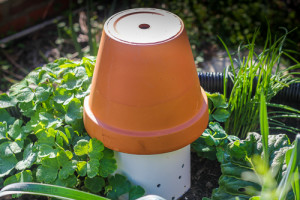 By Karen Retra, Seed Savers Albury-Wodonga
By Karen Retra, Seed Savers Albury-Wodonga
Did you notice all the worms out during the recent rain? Earthworms are great at breaking down organic matter. Their movement underground also helps to aerate the soil. Plus worm castings contain nutrients plants can easily access. Worm activity even increases the soil’s water holding capacity and improves drainage. In short, worms are wonder workers in a garden.
Earthworms will appear in your patch whenever the conditions suit them. However, when it gets too dry, hot, light, wet or there’s not much for them to eat, they will move on and potentially you lose their services.
Keeping a ‘worm farm’ can also deliver many of these benefits, and process your kitchen waste. Worm farms can be purchased or made from repurposed materials. You populate the container with composting worms, which are particularly efficient at eating food scraps (far more so than the earthworms in your garden). Yes, different species of worms have different habits and preferences.
It is important to know how to care for your worm farm. Our summers can be a killer for worms in a worm farm, but it’s avoidable. Worm farms offer an easy way to access worm castings and worm tea (liquid infused with the castings, not the worms!), both of which are valuable garden resources.
I encourage earthworm activity in my garden and also maintain a worm farm. Plus I have a hybrid of these approaches, known as worm towers. A worm tower is a dedicated place in a garden bed into which you place food scraps for the worms to eat. The tower is a pipe or container partially submerged in the soil with holes drilled into it to enable the worms to enter and leave. This way, I feed the worms in just one spot, but they distribute the benefits throughout the bed in their castings and with their movement.
Like worm farms, towers should provide worms protection from light and predators, and be kept moist. I use wet newspaper to help achieve this. These worms appreciate being fed regularly, but unlike in a worm farm, if it gets too hot or dry, they have options to move deeper into the bed to seek shelter. I usually add some compost worms to my worm towers, but often find earthworms working in these beds too.
Keen to know more? I’m presenting at free workshops on worms farms, worms towers and home-made liquid fertilisers at Wodonga library next Tuesday lunchtime and at Willow Park in Wodonga on Sunday 26 July, see www.eco.redsally.com/event for details.
NB: Karen’s handout from this workshop can be accessed as a PDF here.
